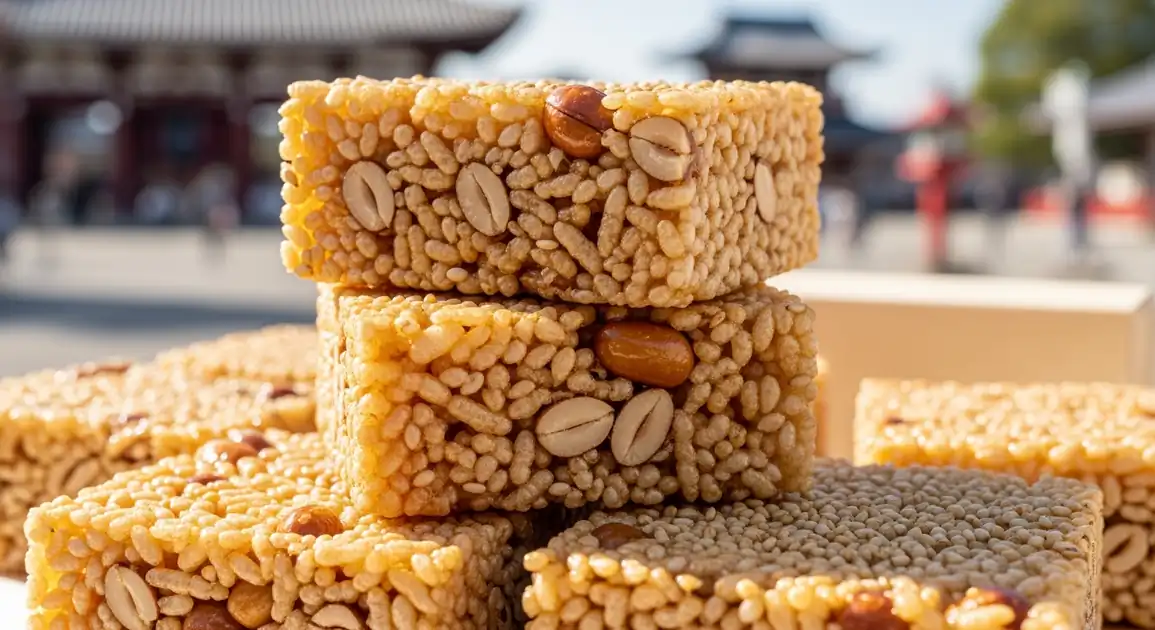Kaminari Okoshi (Puffed Rice Cracker)
雷おこし

Description
Tokyo, and specifically its historic Asakusa district, is the undisputed origin and heartland of Kaminari Okoshi. The bustling Nakamise-dori path leading to Senso-ji Temple is famously lined with numerous shops, some centuries old, dedicated to selling this crispy puffed rice snack. It stands as the quintessential edible souvenir ('omiyage') capturing the traditional flavor of Tokyo.
Dietary Information
Serving information
Serving style
Sold pre-packaged in various sizes and formats, from small plastic bags suitable for personal snacking to elaborate cardboard boxes perfect for gifting. Packaging frequently features iconic Asakusa imagery like the Kaminarimon Gate or Senso-ji Temple Pagoda.
Quick facts
Safety Tips
What to Look For
-
Unexpired, clearly marked 'Best Before' date ('賞味期限' - shōmi kigen)
This date indicates how long the snack will retain its optimal quality, primarily crispness. Always choose packages well within their date for the best experience.
-
Intact, well-sealed packaging (bag or box)
Proper sealing protects the Kaminari Okoshi from air and moisture, which are the main enemies of its crisp texture. Avoid packages that are torn, punctured, or seem loose.
-
Reputable vendors or established brands (e.g., Tokiwado)
Well-known shops, especially those in Asakusa specializing in okoshi, or recognized brands found in department stores, generally adhere to higher quality control standards for ingredients and freshness.
-
Clear ingredient list ('原材料名' - genzairyōmei) if checking allergens
Essential for anyone with allergies to peanuts, sesame, soy, wheat, or gluten. Japanese packaging law requires clear allergen labelling.
What to avoid
-
Packages significantly past the 'Best Before' date
The snack will likely be stale, potentially soft or chewy instead of crispy, and may have an off-flavor. It's generally safe but unpleasant to eat.
-
Damaged, torn, crushed, or poorly sealed packaging
Indicates potential exposure to air and moisture, leading to staleness, or possible contamination. Crushed pieces also detract from the experience.
-
Snacks displayed in direct, prolonged sunlight or overly humid conditions
Heat and humidity can degrade the quality and crispness even before the expiration date, and potentially affect the syrup binder.
-
Unlabelled or dubious homemade versions if ingredient certainty is needed
While potentially charming, unlabelled snacks lack crucial date and ingredient information necessary for ensuring freshness and managing dietary restrictions/allergies.
Price information
Price range
Budget tips
- Small, simple bags purchased directly from vendors on Nakamise-dori might offer the lowest price points (around 500-600 JPY).
- Famous established shops (like Tokiwado) may charge slightly more for their brand recognition and quality.
- Department stores ('depachika') in areas like Ginza or Shinjuku often carry premium versions at higher prices.
- Airport prices might have a slight markup for convenience.
Value indicators
- Crispness is paramount; while hard to test, buying from a busy shop suggests faster turnover and freshness.
- Look for well-known historic brands in Asakusa known for quality.
- Generous ratio of peanuts/sesame seeds visible in the block.
- Packaging should be robust and well-sealed.
- Some shops in Asakusa offer samples ('shishoku').
Where to Find This Dish
Nakamise-dori (Asakusa)
The primary street leading to Senso-ji Temple, packed with souvenir and snack shops, including many specializing in Kaminari Okoshi.
Kaminarimon Gate, Senso-ji Temple, Tokiwado Kaminari-Okoshi Honpo
9 AM - 6 PM
Kaminarimon Gate Area (Asakusa)
The streets immediately surrounding the famous gate also host several Kaminari Okoshi vendors.
Kaminarimon Gate, Asakusa Culture Tourist Information Center
9 AM - 7 PM
Department Store Food Halls ('Depachika')
Find premium brands in major department stores across Tokyo.
Ginza Mitsukoshi, Nihonbashi Takashimaya, Shinjuku Isetan, Shibuya Scramble Square (Shokuhinkan)
10 AM - 8 PM
Tokyo Station Souvenir Areas
Extensive souvenir zones offering specialties from all over Japan, including Kaminari Okoshi.
Tokyo Station Gransta, Daimaru Tokyo (Depachika)
8 AM - 10 PM
Vendor Tips
- In Asakusa, compare prices and package sizes between different shops along Nakamise-dori.
- Look for established shops with long histories (e.g., Tokiwado) for traditional quality.
- Ask shop staff for their recommendation ('osusume wa nan desu ka?') if unsure.
- Check the 'Best Before' date carefully, especially if buying multiple boxes as gifts.
How to Order
Regional Variations
-
Standard Flavors (White/Brown Sugar, Matcha)
(定番の味 (Teiban no Aji))
Tokyo, being the origin, primarily features the classic variations: shirozatō (white sugar), kokutō (brown sugar), and matcha (green tea).
-
Shop-Specific Variations
(店独自のバリエーション (Mise dokuji no bariēshon))
Some long-standing shops in Asakusa might offer unique recipes, slight variations in nut/seed ratios, or occasionally introduce limited-edition or seasonal flavors.
-
Packaging Designs
(パッケージデザイン (Pakkēji dezain))
While not a flavor variation, the packaging itself varies widely, often featuring beautiful depictions of Asakusa landmarks, making it part of the appeal as a Tokyo souvenir.
Cultural context
History
Originating in the mid-Edo period (around the late 18th century) near Senso-ji Temple's Kaminarimon ('Thunder Gate') in Asakusa, Tokyo. Street vendors began selling these lucky rice crackers ('okoshi' implies good fortune and sounds like 'establish'). It quickly became a popular pilgrimage souvenir ('omiyage') and remains inextricably linked to Asakusa's identity.
Local significance
Kaminari Okoshi is deeply interwoven with the identity of Asakusa and Senso-ji Temple. It's more than just a snack; it's a piece of Tokyo's 'shitamachi' (traditional downtown) history and culture, symbolizing good fortune and the enduring appeal of traditional crafts.
Eating customs
- Enjoyed as a simple, crispy snack anytime.
- Pairs well culturally and taste-wise with Japanese green tea.
- Often shared among family or colleagues when brought back as a gift.